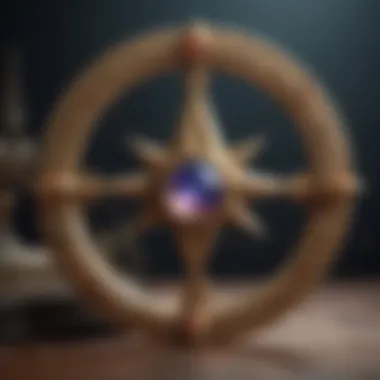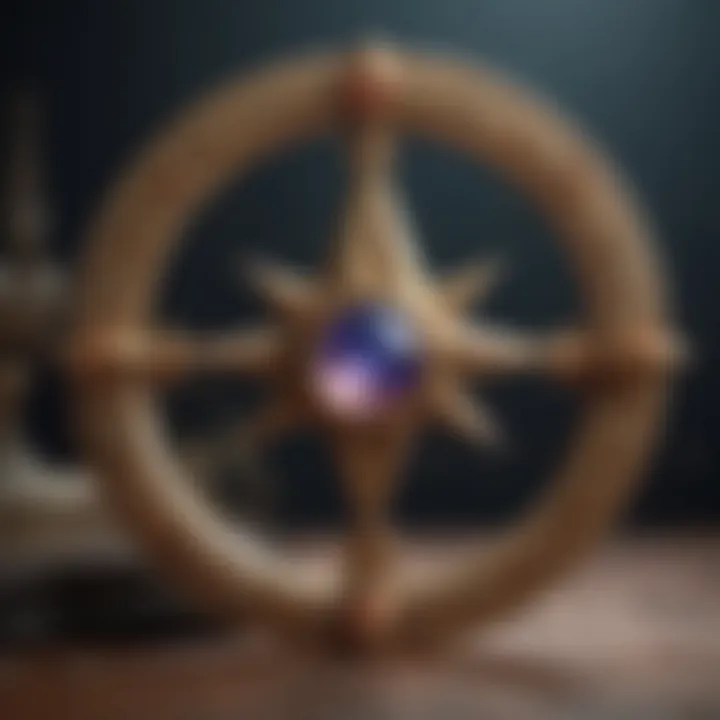Understanding Marriage Chart Astrology's Insights


Intro
Astrology has long been perceived as a window into our souls, offering glimpses into our personality traits, relationships, and life paths. Among various branches of astrology, marriage chart astrology holds a special allure for those striving to grasp the complexities of romantic relationships. This facet of astrology is not merely a collection of predictions; rather, it provides an intricate web of understanding that can reveal the dynamics between partners. In the following sections, we delve into the nooks and crannies of this fascinating field.
Understanding the ins and outs of marriage chart astrology is akin to piecing together a puzzle. Each zig and zag of an individual’s birth chart interacts with another’s, producing a kind of celestial dance that can either harmonize beautifully or create dissonance. By examining the planetary placements, zodiac signs, and houses involved, one can unfold layers of compatibility and potential challenges that come with union.
Whether you are trying to strengthen your bond with a partner or often find yourself gravitating towards certain types in relationships, this article serves as a beacon of light. For enthusiasts and seasoned practitioners alike, we will unravel the key principles, explore the characteristics of zodiac signs, and provide insights into interpreting these celestial maps. Buckle up, as we embark on this astrological journey to deepen our understanding of marriage and partnership dynamics.
Characteristics of Each Zodiac Sign
Overview of personality traits
Each zodiac sign carries its own flavor, contributing to the intricate nature of human relationships. Here’s a brief synopsis of what each sign tends to embody:
- Aries: Bold and adventurous, Aries individuals often exhibit strong leadership traits but may sometimes come off as impulsive.
- Taurus: Grounded and loyal, they value stability and comfort, but can be stubborn when provoked.
- Gemini: Social butterflies, Geminis excel in communication. Their duality can, however, lead to indecision.
- Cancer: Emotionally intuitive, they are nurturing, which can turn into possessiveness at times.
- Leo: Charismatic and confident, Leos seek attention but can be quite generous with their love.
- Virgo: Detail-oriented and analytical, they tend to be perfectionists, which may lead to anxiety.
- Libra: Harmonious and diplomatic, Librans seek partnerships but may struggle with making decisions.
- Scorpio: Intense and passionate, Scorpios are known for their loyalty and depth, yet risk becoming secretive.
- Sagittarius: Free-spirited and optimistic, they may face challenges with commitment.
- Capricorn: Ambitious and disciplined, Capricorns are practical but might appear cold.
- Aquarius: Innovative and independent, they value freedom but may sometimes come off as aloof.
- Pisces: Compassionate and artistic, they are dreamers who can be overly sensitive.
Strengths and weaknesses
With strengths come weaknesses. Understanding both sides helps in navigating relationships:
- Aries: Strengths include fearlessness; weaknesses can lead to recklessness.
- Taurus: Reliable, yet can be hard-headed.
- Gemini: Communication prowess is high, but they may lack focus.
- Cancer: Deeply caring, they can sometimes withdraw too easily.
- Leo: Exudes joy, but craves validation.
- Virgo: Organized, yet may be overly critical.
- Libra: Sociable but indecisive.
- Scorpio: Committed, but their intensity can scare others.
- Sagittarius: Open-minded, though can be easily bored.
- Capricorn: Strategic, however, may neglect emotions.
- Aquarius: Visionary but may appear detached.
- Pisces: Empathetic, but can be naïve.
Compatibility with other signs
While sun signs play a critical role in compatibility, they are only part of the picture in marriage chart astrology.
- Aries often pairs well with Leo and Sagittarius for an adventurous connection.
- Taurus finds solace with Virgo and Capricorn in their stable relationships.
- Gemini can click with fellow air signs, Libra and Aquarius, for social vibrancy.
- Cancers usually connect deeply with fellow water signs, Scorpio and Pisces, nurturing emotional bonds.
- Leos shine brightest alongside Aries and Sagittarius, drawing out their creativity.
- Virgos thrive with Tauruses and Capricorns, valuing practicality.
- Libras enhance connections with Gemini and Aquarius, creating cooperative partnerships.
- Scorpios bond intensely with Cancer and Pisces, delving into emotional depths.
- Sagittarians pair with Aries and Leo to maintain an adventurous spirit.
- Capricorns are well-matched with Taurus and Virgo, aligning ambitions.
- Aquarians thrive around Gemini and Libra, emphasizing intellectual connections.
- Pisces often find comfort in Scorpios and Cancers, resonating with emotional sensitivity.
Understanding these characteristics lays the groundwork for comprehending how astrology influences relationship compatibility, paving the way for deeper insights in the sections to follow.
Understanding Marriage Chart Astrology
Marriage chart astrology is like a treasure map, offering profound insights into the dynamics of romantic relationships. Understanding this intricate system allows individuals to navigate their partnerships with greater awareness and purpose. The nuances embedded in the astrological charts can shed light on compatibility, challenges, and overall relationship dynamics in a way that mere observation often cannot. The depth of this practice goes beyond the superficiality of love horoscopes; it delves into the very fabric of a couple's potential together, weaving in the influence of celestial bodies.
The importance of grasping marriage chart astrology lies in its ability to:
- Provide clarity: Deciphering astrological placements can reveal unseen forces at play in relationships, helping couples understand each other better.
- Foster growth: By pinpointing areas of conflict or misunderstanding, partners can work consciously toward growth and transformation.
- Cultivate resilience: Recognizing patterns in relationship dynamics can prepare individuals for bumps along the road, fostering a sense of resilience in adversity.
Engaging with this field requires some effort and thought, as it involves not just looking at one’s own chart but also mapping it against that of a partner. This practice of comparative astrology can unveil layers of compatibility and challenges, producing a rich tapestry of relational understanding.
Definition and Purpose
In essence, marriage chart astrology revolves around interpreting specific astrological placements that influence partnership dynamics. At its core, the marriage chart functions as a specialized segment of an individual’s natal chart that focuses on romantic relationships.
The purpose of a marriage chart is to identify how celestial alignments at the time of someone's birth affect their ability to connect in their intimate relationships. This chart assists in pinpointing:
- Compatibility markers: Key planetary placements often indicate inherent compatibility or challenges within a relationship.
- Potential growth areas: Understanding what strengths can be enhanced or weaknesses mitigated is crucial for the longevity of a connection.
- Reflection of needs: Every person has unique emotional and physical needs influenced by their astrological make-up, which can be highlighted through chart interpretation.
By anchoring relationships in such astrological insights, individuals can approach their love lives from a more informed perspective, fostering deeper connections.
Historical Context
The roots of marriage chart astrology stretch back through centuries, intertwining with the cultural, spiritual, and astrological traditions of various civilizations. From Babylonian astronomers recording celestial patterns around 2000 BCE to the evolution of Western astrology in the Hellenistic period, the concept of using stars to forecast human relationships has always been of interest.
Particularly in ancient Indian astrology, known as Jyotisha, marriage charts are pivotal. Astro-pundits often referred to the concept of "koota" or matching charts, to determine compatibility before marriage. Similarly, in Western tradition, figures like Johannes Kepler and Ptolemy contributed foundational knowledge that astrologers still reference.
Astrology evolved, adapting to modern times, yet remained steadfast in its role as a guiding light for relationships. Now, numerous practitioners utilize these insights not only to delineate potential romantic outcomes but also to enhance self-understanding and enrich interpersonal connections.


Key Components of Marriage Charts
In the realm of marriage chart astrology, understanding the key components is akin to deciphering a complex code. Each component contributes a distinct hue to the overall narrative, reflecting the unique dynamics of a relationship. The significance of these elements lies not only in their individual strengths but also in how they interact with one another to create a rich tapestry of energies that influences romantic connections.
Focusing on specific elements, such as the Ascendant, the Seventh House, and the roles of Venus and Mars, helps astrologers gain insights into compatibility and relational challenges. Moreover, considering how these components work together helps to cultivate a deeper appreciation for the intricate dance between celestial influences and human experiences.
The Ascendant and its Role
The Ascendant, often referred to as the Rising Sign, plays a pivotal role in any astrological chart, and its significance magnifies within marriage charts. It is the facade that a person presents to the world, often reflecting first impressions and initial interactions. In the context of relationships, the Ascendant shows how partners come together, interact, and resonate with one another.
When examining the Ascendant of both partners, one can glean insights into how they approach life and, by extension, their relationship. For instance, someone with an Aries Ascendant might approach partnership with enthusiasm and a direct approach, while a partner with a sensitive Cancer Ascendant may offer a more nurturing and contemplative perspective. Understanding these differences is crucial in navigating the complexities of love and partnership.
Additionally, the Ascendant influences the general atmosphere of the marriage chart. A vibrant Leo Ascendant can bring a sense of playfulness and creativity, while a more stoic Capricorn Ascendant might introduce a layer of responsibility and seriousness. These contrasting energies can lead to both cohesiveness and friction, depending on the awareness and adaptability of each partner.
Understanding the Seventh House
The Seventh House, often referred to as the house of partnerships, holds immense weight in marriage chart astrology. It encapsulates the themes of commitment, cooperation, and the dynamics of relationships. Unlike the Ascendant, which indicates individual expression, the Seventh House reflects the interpersonal aspects of a relationship.
One crucial component to consider in the Seventh House is the presence of planets. For example, if Venus resides in the Seventh House, this may suggest a loving and harmonious relationship. Conversely, if Saturn occupies this house, it might indicate potential challenges, hard work, or lessons in discipline within partnerships.
Moreover, this house also highlights what each individual seeks in a partner. It acts as a mirror, revealing the qualities desired in a spouse or significant other. This aspect can often create a powerful pull, where individuals might find themselves gravitating toward partners who resonate with their subconscious needs or desires. The characteristics of the sign on the cusp of the Seventh House offer additional insights into the general approach towards relationships.
The Role of Venus and Mars
In the dance of love, Venus and Mars are often seen as the leading characters. While Venus embodies love, beauty, and attraction, Mars represents passion, drive, and assertiveness. Their roles within the marriage chart are essential for recognizing relational strengths and potential conflicts.
When Venus is strong in a chart, it can indicate a lover who values harmony and emotional connection above all. This placement often signifies a tendency to seek pleasure and enjoyment in relationships. On the flip side, a potent Mars influence can usher in an energetic and dynamic atmosphere, often sparking excitement but also potential clashes if both partners' energies do not align.
The interaction between Venus and Mars becomes particularly insightful when analyzing compatibility. A harmonious aspect between the two can result in a relationship with both emotional depth and vibrant passion. However, if they clash, it might signify a struggle between emotional needs and physical desires, leading to misunderstandings and conflict.
Ultimately, understanding the roles of Venus and Mars in the marriage chart allows astrologers to uncover the layers of attraction and compatibility that may exist between partners, enriching their comprehension of one another and their journey together.
Planetary Influences on Relationships
Understanding how planetary movements influence relationships is crucial for interpreting marriage charts. These celestial bodies don't just dictate traits of individuals; they shape dynamics and interactions in partnerships. Astrologers often look at specific planetary alignments to glean insights into how partners support, challenge, or transform one another.
By examining how the planets interact through transits and aspects, one can discern patterns or shifts that might affect a relationship's course. This understanding allows for deeper reflection about one’s romantic journey and personal growth. It underlines the belief that while the cosmos can set the stage, it ultimately falls to individuals to navigate the play.
The Impact of Outer Planets
Outer planets like Uranus, Neptune, and Pluto often symbolize broader and more transformative energies when it comes to relationships. Unlike the inner planets that govern immediate and personal interactions, these outer bodies influence long-term trends and deeper layers of partnership.
- Uranus: Known as the planet of unpredictability, Uranus can bring sudden changes or awakenings to relationships. A partner’s Uranus placement might suggest areas where spontaneity and freedom are essential, indicating a need for flexibility and personal space.
- Neptune: Linked to dreams and illusions, Neptune’s influence on partnerships often relates to idealism. When this planet is prominent in a marriage chart, partners may experience a deep spiritual connection or face challenges stemming from unrealistic expectations.
- Pluto: As the harbinger of transformation, Pluto shakes the foundations of relationships, exposing hidden truths and prompting personal evolution. Couples might find themselves facing power struggles or deeply shared emotional journeys when Pluto is in play.
"It’s not merely the planet’s placements, but their aspects to personal planets that weave the intricate tapestry of relationship dynamics."
Transits and Progressions
Transits and progressions are critical tools in marriage astrology, offering insights into how current celestial movements affect relationships. Transits occur when planets move into new signs or directly interact with the charts of individuals, highlighting periods of potential growth or turbulence.
- Transits: When considering transits in a marriage chart, even a fleeting moment can have a lasting impact. For example, when Saturn, the planet of structure, transits the seventh house, it might bring themes of commitment, responsibility, and sometimes challenges that require addressing issues within the relationship.
- Progressions: These represent a more personal and internal dimension of growth. In the case of a natal Venus progressing into a different sign, a partner might find their values and desires evolving, prompting a reassessment of the relationship itself.
Both transits and progressions can be seen as cosmic checkpoints that offer opportunities for reflection and growth within partnerships. They serve as reminders that relationships are not static; they are living entities that evolve in sync with the universe.
Understanding these planetary influences enriches the practice of marriage chart astrology, providing a lens through which relationships can be both interpreted and actively cultivated.
Interpreting the Marriage Chart
Interpreting the marriage chart is akin to navigating a labyrinth filled with intricate pathways and secret rooms. Each twist and turn can lead one to deeper insights into the dynamics of a relationship. This process is critical, as it not only reveals compatibility but also lays bare potential challenges and strengths between partners. Whether one is an experienced astrologer or a curious newcomer, understanding how to read these charts can greatly assist in both personal and relational development.


Analyzing Compatibility
Compatibility is the cornerstone of any healthy relationship and analyzing it through marriage charts enhances this understanding significantly. By examining the positions of planets, signs, and houses, one can gather clues about how well two individuals harmonize in various aspects of life. For instance, if one partner’s Venus aligns harmoniously with the other’s Mars, sparks are likely to fly, indicating a natural attraction and shared values regarding love and desire.
Moreover, looking at the 7th house—the domain of partnerships—gives deeper insights into how each partner approaches relationships. If there’s a strong emphasis on similar elements such as air or fire signs, it suggests an ease in communication and shared enthusiasm. Conversely, tense aspects—like squares or oppositions—can serve as red flags, indicating areas where friction could arise. This nuanced analysis is what allows astrologers to craft tailored guidance for couples seeking to navigate their relationships more successfully.
Key Configurations to Note
When delving into marriage charts, not all configurations are created equal. Some alignments can significantly influence the relationship’s trajectory. For instance:
- Venus and Mars relationships: Often reveal how partners express love and attraction.
- Sun-Moon connections: Indicate an emotional bond and understanding between partners.
- Saturn aspects: May bring challenges but also strength and durability in long-term commitments.
Each of these configurations provides a unique lens through which to view the partnership. For example, a challenging Saturn aspect might initially feel burdensome, but it could also encourage both partners to work collaboratively through their issues, fostering mutual growth.
Identifying Challenges
Recognizing potential roadblocks is as crucial as understanding compatibility. Astrological interpretations shine brightest when they bring awareness to challenges that might not be readily apparent. Indicators such as:
- Afflicted Venus or Mars: Can denote struggles in expressing affection or intimacy.
- Unfavorable placements in the 7th house: Might signal difficulties in commitment or understanding each other's needs.
- Transiting planets in hard aspects: Can trigger significant changes or upheavals in the relationship dynamic.
It’s imperative to chart these elements to create a full picture. Identifying challenges does not only serve as a warning; it illustrates areas for growth and transformation. Thus, when partners are aware of their astrological profiles, they can proactively address these challenges, creating a stronger bond while cultivating understanding and forgiveness.
"Astrology does not bind us. It frees us to understand the potentials of our relationships!"
In summary, interpreting the marriage chart is a multi-layered endeavor that combines analysis of compatibility, key configurations, and potential challenges. By looking at these aspects through an astrological lens, one can glean profound insights and cultivate healthier relationships. The journey through this cosmic map enables a deeper appreciation for each partner's role, fostering both individual growth and shared experiences.
Comparative Analysis of Charts
When it comes to understanding the nuances of romantic relationships, Comparative Analysis of Charts acts like a telescope through which one can scrutinize the complex dynamics at play. This section emphasizes the importance of looking beyond individual charts to assess compatibility and chemical attraction. The very essence of astrology lies not just in the planets and houses of a single individual, but rather how these celestial elements dance together in the context of a relationship.
Through comparative analysis, astrologers can glean deeper insights into how two charts interact. This involves examining not just the synergies and strengths found within compatible placements but also noting potential friction points that may arise. Identifying these elements can yield significant advantages when navigating relationship dynamics, helping both partners develop a roadmap for harmony.
Synastry: Layering Charts
Synastry serves as the cornerstone for comparative analysis. It is the art of layering two charts on top of one another, allowing for a real-time astrological interaction review. This method reveals how the planets of one person influence those of the other, thereby creating a unique relationship profile.
In this analysis, key points of note include:
- Conjunctions: When planets align closely, the energy is intensified, often indicating areas of attraction or mutual support.
- Oppositions: While these can create tension, they also provide opportunities for growth and balancing energies.
- Trines and Sextiles: Such harmonious aspects spark ease in communication and understanding between partners.
For instance, if one partner's Venus (the planet of love) forms a trine with the other partner's Mars (the planet of action), it suggests a potent romantic chemistry. However, if Saturn appears prominently in the mix, caution might be warranted since it may introduce elements of seriousness or restriction. This underscore the need for practitioners to interpret not just superficially, but to engage deeply with the intricate interplays.
Composite Charts Explained
Composite charts provide an additional layer of comprehension by creating a single chart from two individuals' data. This chart symbolizes the relationship itself, reflecting its strengths, challenges, and overall trajectory. Instead of focusing solely on individual personalities, a composite chart allows one to see the relationship's potential as an independent entity.
Important elements in composite charts include:
- The Ascendant: This reveals how the relationship is perceived externally and can show where challenges may arise.
- Midheaven (MC): Important for understanding shared goals and public image.
- Planetary Placements: Each placement tells a story about how the couple will interact in various life scenarios.
For example, if in a composite chart, the Sun is in the Fourth House, it suggests that home and family life may become a focal point for the relationship. Conversely, if the Moon is linked to the Eighth House, it may indicate themes of intimacy, transformation, and shared resources.
"In astrology, understanding the relationship is as crucial as understanding the individuals themselves."
In summary, Comparative Analysis of Charts represents a multifaceted approach that astrological practitioners can employ to gain a more comprehensive understanding of relationship dynamics. By incorporating both synastry and composite charts, enthusiasts and professionals alike may uncover enriched insights that aid in navigating the beautiful intricacies of love.
Real-Life Applications of Marriage Chart Astrology


Marriage chart astrology isn’t just a theoretical exercise; it has real implications for those looking to understand or navigate their relationships. By employing various astrological techniques, individuals can gain unique insights that help them cope with challenges, foster growth, and deepen connections. The fundamental elements here revolve around the ability of astrology to act as a mirror, reflecting not only personal desires but also potential conflicts and resolutions.
Navigating Relationship Issues
One of the significant advantages of utilizing marriage chart astrology is its capacity to guide individuals through turbulent waters. Relationship issues often stem from misunderstandings or misalignments that could be identified through astrological charts. For instance, examining the aspects between planets in a marriage chart can highlight areas of friction or tension, giving partners a clearer view of their dynamic.
A specific example could involve looking at Venus and Mars placements in the charts. If one partner's Venus is opposed to the other's Mars, it might suggest that their romantic and assertive natures clash, leading to frequent arguments or frustrations. Recognizing such patterns provides a tangible context, allowing couples to address the root causes rather than getting lost in surface disputes.
Moreover, the effects of transits can also be pivotal. When a difficult transit occurs, such as Saturn moving through key relationship houses, it can indicate a phase where partners might feel restricted or pressured. Awareness of such influences helps individuals navigate these periods with more understanding and patience, fostering stronger connections over time.
Using Astrology for Relationship Growth
Astrology also plays a pivotal role in fostering relationship growth. By utilizing marriage charts as a roadmap, couples can identify strengths and weaknesses in their relationship dynamics. This proactive approach allows partners to work together more effectively, improving their understanding of each other.
For instance, if the chart analysis reveals a strong Mercury influence, partners may find that communication is a key strength. They can nurture this by establishing regular times to check in with each other, thus preventing misunderstandings. In contrast, weaker areas, like a challenging aspect between the Sun and Moon, may suggest emotional disconnects. Partners can then focus on enhancing their emotional intelligence, perhaps through shared activities or therapy.
Additionally, the practice of synastry can also yield benefits. By overlaying both partners’ charts, it's possible to visualize how their energies interact. This perspective grants clarity and helps to align joint goals, whether in terms of family planning, career aspirations, or personal development.
"Astrology serves as a mirror, reflecting the complex layers of our interactions and motivations."
Integrating insights from astrology can facilitate conversations about long-term goals and emotional needs, ultimately enriching the relationship.
Considerations
It's vital to remember that while astrological insights can be beneficial, they’re not a substitute for active engagement and communication in relationships. They serve as a tool, a lens through which to view shared experiences and feelings. Therefore, utilizing marriage chart astrology should be one component of an ongoing dialogue aimed at nurturing growth, understanding, and harmony.
Common Misconceptions in Marriage Astrology
When diving into the realm of marriage chart astrology, understanding its intricacies is essential. Often, both practitioners and novices come across misconceptions that cloud their understanding. These misunderstandings can lead to misguided perceptions of what astrology can offer in regards to relationships. This section will clarify some common myths and shed light on why it’s vital to grasp these concepts.
Astrology vs. Fate
A frequent misunderstanding is the idea that astrology dictates one’s fate, making individuals mere puppets in a play orchestrated by celestial bodies. This notion is not only inaccurate but it undermines the very essence of astrological practice. Astrology provides a map, a guide to understanding the potentials and challenges inherent in a relationship. It highlights your tendencies based on planetary placements and alignments, yet it does not reduce you to a predetermined script.
For instance, the placement of Venus might signal certain preferences in love, such as the need for romance and affection, while a challenging aspect might indicate difficulties in expressing love. But it’s essential to remember that these insights serve as a framework to navigate your free will. After all, one could choose to act differently when confronted with astrological influences. Astrologers often say, "The stars impel, they do not compel." This rings true, emphasizing that the exercise of choice remains firmly in one’s hands.
“Astrology is a language. If you understand this language, the sky speaks to you.” – Dane Rudhyar
The Role of Free Will
Free will plays a crucial role in marriage astrology. Contrary to portraying individuals as passive observers in their lives, astrology emphasizes that we have the power to enact change. While the charts may show predispositions or challenges, it is through personal discernment that one can choose a path that aligns with their values and goals. Understanding this dynamic reveals the importance of self-awareness in relationships.
• Making Conscious Choices: It’s vital to reflect on astrological insights, not as prescriptions but as areas for self-improvement and growth. Each chart tells a story, and it’s through our choices that we become the authors.
• Learning Through Experiences: Difficult aspects can indicate challenges, yet they may also serve as opportunities for growth. Recognizing these potential hurdles can encourage proactive communication with partners and foster deeper connections.
• Balancing Intuition and Logic: It’s essential to blend intuitive feelings with rational interpretations of charts. This balance empowers individuals to make informed decisions, leading to healthier interactions with their partners.
Closures and Insights
The conclusions drawn from the exploration of marriage chart astrology reveal profound insights into the dynamics of personal relationships. Understanding the intricate interplay of celestial influences helps individuals recognize the underlying patterns that may govern their connections. This section emphasizes the significance of analyzing marriage charts not only for compatibility assessment but also for personal growth. Evaluating these astrological insights can illuminate aspects of one’s self and partner that might otherwise go unnoticed.
Synthesis of Key Findings
The journey through marriage chart astrology has uncovered several key findings:
- Planetary Placements Matter: The positions of planets at the time of one's birth create unique energies that play a vital role in shaping relationship dynamics.
- The Seventh House: This area of the astrological chart encapsulates partnerships, embodying the themes of marriage and committed relationships. An analysis of this house offers a glimpse into what individuals truly seek in a partner.
- Venus and Mars Interactions: The dance between Venus and Mars in a marriage chart can shed light on attraction, passion, and the overall chemistry between partners. Their aspects can highlight areas of harmony or tension within the relationship.
- Role of Free Will: While astrology provides a framework for understanding relationships, it is essential to remember that free will plays a crucial role. Choices made by individuals can alter the dynamics suggested by their charts.
- Navigating Challenges: Identifying challenging aspects in a chart can prepare individuals for potential conflicts, allowing them to engage with issues more constructively.
Thus, the marriage chart does not dictate the course of a relationship but offers critical insight and better navigation strategies for couples.
The Future of Marriage Astrology
Looking ahead, marriage astrology seems poised to grow in relevance and application. As individuals increasingly seek self-awareness and understanding in a rapidly changing world, the insights gained from marriage charts can provide guidance and clarity. Here are some expectations for the future:
- Increased Personalization: The integration of technology in astrology can create tailored forecasts and compatibility reports, allowing individuals to receive personalized guidance from their marriage charts.
- More Collaboration between Disciplines: The crossover of astrological insights with psychological and relationship counseling practices may become more commonplace. This collaboration can enhance the overall understanding of relationship dynamics and individual needs.
- Focus on Inclusion: As marriage astrology evolves, there is a growing recognition of diverse relationship structures. Future discourse may explore charts for non-traditional partnerships, emphasizing that astrology can cater to a broader audience.
- Educational Growth: Resources and courses on marriage chart astrology are sure to expand. This growth will empower more individuals to harness astrological insights for their own personal development and relationship enhancement.







